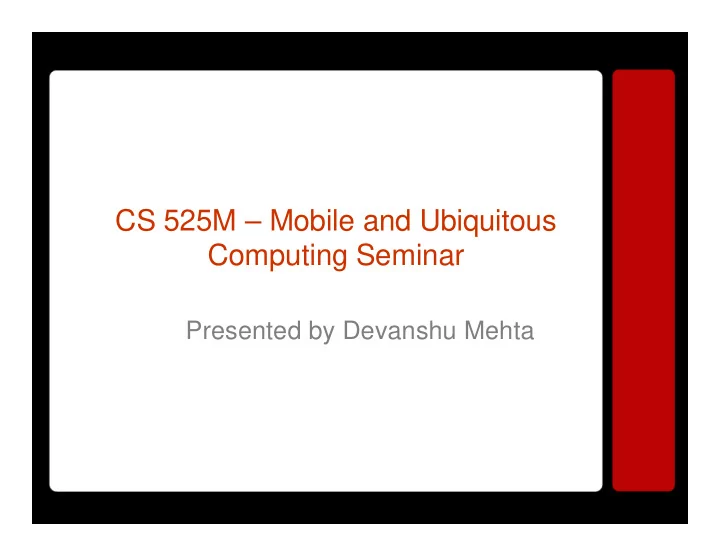

CS 525M – Mobile and Ubiquitous Computing Seminar Presented by Devanshu Mehta
Introduction • Improving TCP Performance over Wireless Links –Motivation –Types of Solutions –Related Work –Implementation –Results –Conclusions
Motivations • TCP is geared towards handling packet loss due to congestion. • Losses on wireless connections are usually just due to the nature of the links. • Sporadic high error rates • Intermittent connectivity • In such a situation, TCP assumes congestion and goes in to slow start. • This degrades performance since the connection can actually handle a much higher throughput.
Proposed Solutions • End to End – Attempt to make TCP sender handle losses using: • Selective ACKs (SACK) • Explicit Loss Notification (ELN) • Split Connection – Hide the wireless link from the sender; different protocol over wireless hop. • Link-Layer – Hide loss from sender through local retransmissions and forward error correction.
Purpose of Experiments • What combination of mechanisms results in the best performance for each of the protocol classes? • How important is it for link-layer schemes to be aware of TCP algorithms to achieve high end- to-end throughput? • How useful are selective acknowledgements in dealing with lossy links, especially in the presence of bursty losses? • Is it important for the end-to-end connection to be split in order to effectively shield the sender from wireless losses and obtain best performance?
Implementation Details
Results: Methodology •BSD/OS TCP Reno •First tested with average •Focuses on traffic TO error rate of 1 in 64kb mobile device. •The tested with bursty •Exponentially distributed errors bit error model •The results should be •Losses generated in consistent for other both directions patterns of losses as well •No losses due to congestion
Results: Link-Layer
Results: Link-Layer • LL-TCP-AWARE has better performance than LL because of in-order transmission of packets. • In pure LL, out of order packets cause duplicate ACKs and hence invoke fast retransmit. • This degradation is more acute on WANs.
Results: End-to-End
Results: End-to-End
Results: End-to-End • E2E < E2E w/Partial ACK < E2E w/ELN < E2E w/Selective ACKs • ELN performs better because of sender’s awareness of wireless link. • E2E based on Selective Acknowledgement (SMART and IETF) schemes work best among E2E (1.25Mbps). • Still, they do not perform as well as the best of the LL schemes (1.39Mbps).
Results: Split Connection
Results: Split Connection
Results: Wrapping Up • Burst Errors: • SMART Selective ACKs better than simple LL- TCP-AWARE
Purpose – Reloaded! • What combination of mechanisms results in the best performance for each of the protocol classes? – LL-SMART-TCP-AWARE • How important is it for link-layer schemes to be aware of TCP algorithms to achieve high end- to-end throughput? – Important! • How useful are selective acknowledgements in dealing with lossy links, especially in the presence of bursty losses? – Very Useful! • Is it important for the end-to-end connection to be split in order to effectively shield the sender from wireless losses and obtain best performance? – Yes!
Conclusions • A reliable link-layer protocol that uses knowledge of TCP (LL-TCP-AWARE) is best among LL protocols as it gives best throughput and least retransmissions. • LL protocols also perform better than Split Connection schemes proving the split is not necessary for improved performance. • SMART schemes with SACK perform best among end-to-end; but not as good as LL. • End-to-End provide improved performance and are promising as they require no support at intermediate nodes.
Recommend
More recommend